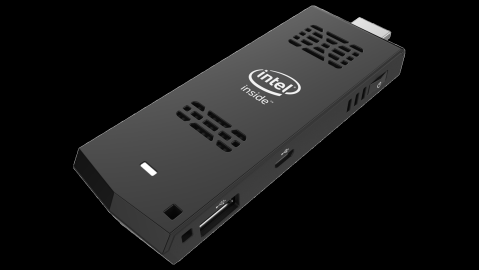Review: Intel's computer-on-a-stick: Awesome idea, but its day hasn't arrived

Are you interested in a Windows computer you could carry around in your pocket, plug into a television screen and do basic computing?
Intel hopes so. The chipmaker has introduced the Compute Stick, a complete Windows 8.1 computer that weighs less than 2 ounces and runs applications like Microsoft Office on newer televisions or displays.
It's one of several new miniature PCs just reaching the market that plug into the back of HDMI-capable TV screens or displays. Google is introducing the Chromebit, which looks like an oversized flash drive. A company called Hannspree makes a micro-PC that is similar to the Compute Stick.
Maybe because it's made by the world's biggest chip company, the Intel gadget has received the most attention, stirring a heated debate among tech reviewers. Gizmodo's review is headlined "Don't buy it!" while Seeking Alpha's review starts with "Smart Buy."
"What's not to like? ... almost everything," Gizmodo's reviewer wrote.
"It isn't a powerhouse, but you get a lot for what you pay for," Seeking Alpha said.
"Nothing more than a prototype for now," the reviewer for Engadget opined.
The idea of a tiny computer weighing less than 2 ounces that I could plug into the back of my TV sounded intriguing despite the mixed reviews, so I got a loaner from Intel.
Our IT person looked it over, listened to its tiny cooling fan whirring away, and gave it a one-word review: "Amazing."
I had visions of browsing the Internet on my family room TV, but first I tried the Compute Stick out on the small television next to my desktop computer. The recommended way to set the gadget up is to use a powered USB hub for a wired mouse and keyboard, then switch to Bluetooth devices after it's up and running.
Why does this have to be so complicated? I was beginning to feel like I'd been time-warped back into the days of DOS.
With two keyboards, two mice and one newly acquired powered USB hub, I plugged it in and launched Windows 8.1. Then I tried it on the older 40-inch Sony TV in our family room, which has a single HDMI port.
I'll spare the gory details, but basically the stick doesn't work on my older TV. It shut down with a "pop" when I tried to launch Windows 8.1.
"On some of the older single HDMI connector displays, there can be back drive current on the connector that will impact the functionality of the Compute Stick," Intel's tech contact emailed me after I sent up a flare for help. He said that's still being examined.
I plugged the Compute Stick into my newer TV (it has two HDMI ports), but the Stick had stopped working. Maybe it was those "pops."
I returned it and Intel sent me a replacement, saying that my issue hasn't been seen on any TVs which Intel has tested the Compute Stick, but there could be "compatibility issues with any number of displays that are out in the world. There is just no way to test them all and to know what will and will not work."
The second time, it started up without a hitch and launched Windows. I browsed around and opened YouTube to Dizzy Gillespie's version of "No More Blues," opened the San Jose Mercury News website and wrote an email to a friend. On a TV!
But while typing and YouTubing simultaneously is possible, it's painfully slow. Intel says more powerful versions are on the drawing boards, so that kind of multitasking may not be an issue in future versions. There also are reports that the next version won't need to be plugged into a wall outlet.
In the judgment of our research director, the Compute Stick is not going to get PowerPoint presenters to abandon their laptops and projectors. And there are other ways to browse on a TV, including the new Chromebit.
Other uses may come along if the Stick gains any traction in a crowded marketplace for portable devices. It could be a way to cheaply upgrade classroom computers. A traveler might use it with a hotel room TV; an artist could display work on a large screen instead of a little laptop. Maybe businesses that do not have assigned desks could give employees a Stick to log on at any desk where a display is available.
There are problems that Intel needs to work on. At one point I had to reboot, and it took 15 minutes for Windows to shut down and 8 minutes to restart. The Intel guy said that happens after doing any updates.
Intel seems to be onto something, but at this point, it's a solution looking for a problem. When I look at the various reviews, I'm inclined to go with the guy who flagged the Stick as a prototype. The actual device is amazing, as our IT guy said, but it needs an upgrade and some fine-tuning.
—-
STICK SPECS
Intel's Compute Stick is underpowered at this point. It could use a RAM upgrade and a more powerful processor, but cramming a PC into such a tiny device is quite a feat. Here's what's in it:
Atom processor; 2 GB of RAM; 32 GB of storage
1 USB 2.0 port, 1 HDMI connector, 1 microSD slot
A power adapter and attachments with a 3 foot cable. An 8-inch HDMI extender cable
Built-in 802.11 wireless and Bluetooth 4.0
Windows 8.1
Size: 3.9 inches by 1.5 inches by 0.4 inches. Weight 1.9 oz.
©2015 San Jose Mercury News (San Jose, Calif.)
Distributed by Tribune Content Agency, LLC.




















